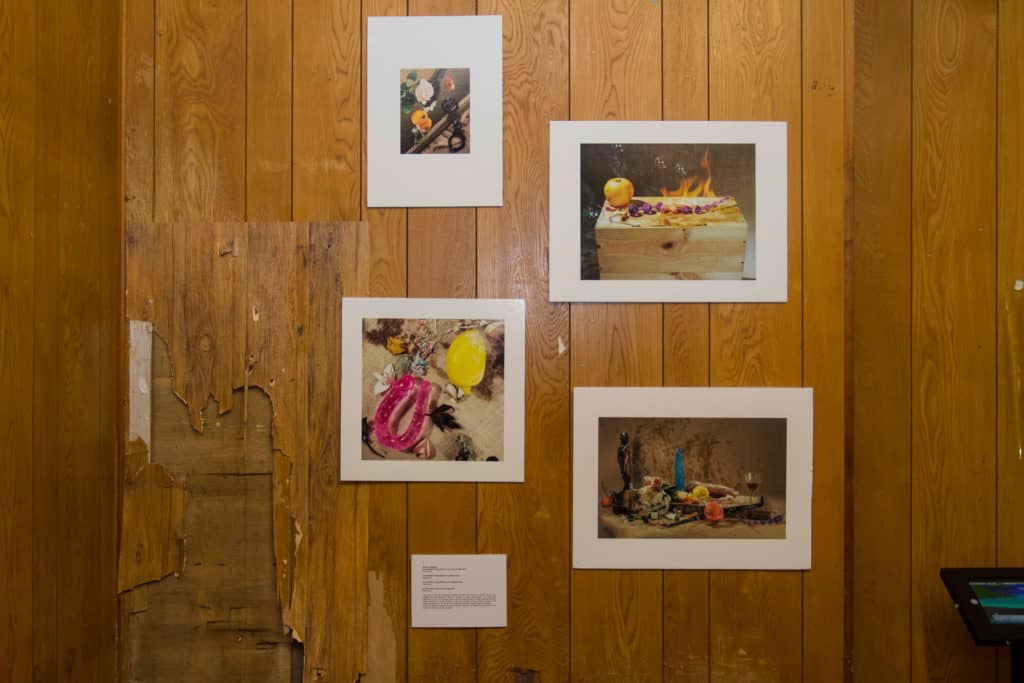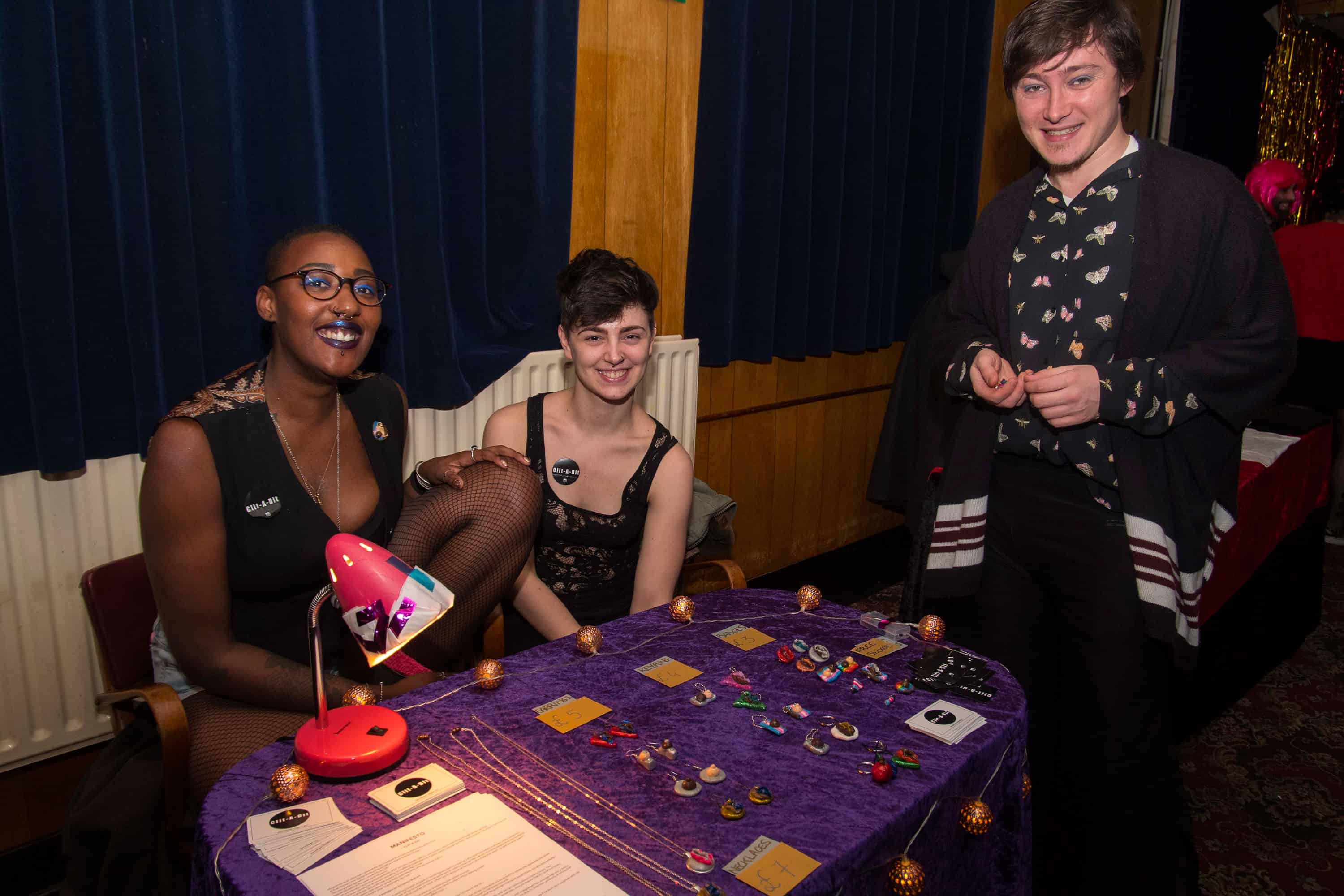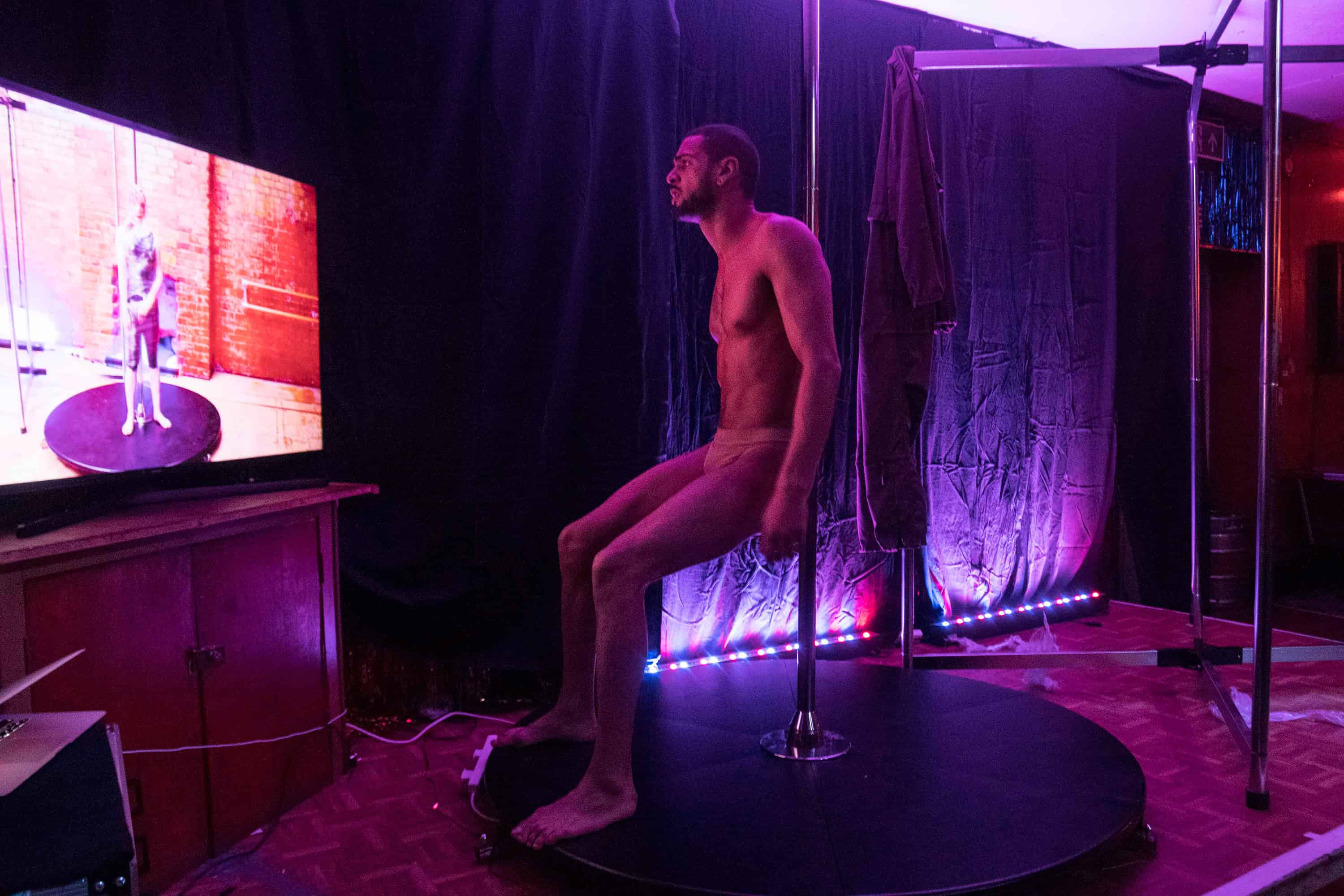DTR team © Orlando Myxx, 2018. At Bethnal Green Working Men’s Club
The week before Valentines Day queer and feminist organisation Cuntemporary curated an unconventional academic symposium titled ‘Love, Pain & Intimacy in Live Art’, and celebratory club night ‘DEEP TRASH Romance’. On this occasion, the collective endeavoured to bolster a platform for queer and public intimacies through the medium of live art. Conventional heteronormative narratives of love and intimacy were replaced by queer single parenting, sexual/asexual encounters, body augmentation through piercing and self-tattooing, Black dance communities, and queer femme encounters, amongst others.
Threads of pain and desire weaved their way throughout the two events, as artists turned inwards into their bodies – some literally through the process of piercing, wounding, penetrating the flesh – to mediate intimacies and affection. Why has physiological pain and desire been a source of fascination and mode of enquiry, even obsession, for performance artists? Live artist and academic Dominic Johnson articulated these arguments in his keynote lecture at the symposium, which took place at Queen Mary University, London on Thursday 8th February 2018. Satiating the audience with the trajectory of the performance medium, he acknowledged, amongst others the significant contributions Marina Abramovic has made to the canon. This left me thinking of the widely circulated reunion between her and her former romantic partner and collaborator Ulay at MoMA in 2010, its affective potency remains sedimented in the collective consciousness of what we regard as pillars of the genre. One YouTube clip of the encounter has garnered over 15 million views, revealing our longing for digital intimacies and our emotional connection to the digital screen.

set design © Orlando Myxx, 2018. At Bethnal Green Working Men’s Club
Following Johnson, Nicola Hunter, Rachael Young, Ivan Lupi, and Emie // Eva-Marie Elg as E-ME 2.0 expressed their art practices, the latter of whom in the most unusual method. The performance artist, who is based in Malmö and London embodied a cyborg sex-doll for her presentation. She was wheeled onto the stage, her limp body hung stiff, and her eyes were locked in a vacant stillness akin to the gestures of robots. E-ME 2.0 pledged a tangled and interwoven manifesto of alternative modes of intimacy, sex-positivity and asexuality, commenting on contemporary sexual culture.
In contrast to E-ME 2.0’s clinical delivery, artist Nicola Hunter’s presentation incorporated graphic and visceral imagery. A performance artist and activist born in North East England (UK), they have been performing for over 10 years, founding the intersectional feminist project ‘Raising the Skirt’. As a single parent, Hunter spoke of their creative practice as inextricably rooted to their lived experiences, having mutilated and wounded their body countless times, their blood, breast-milk, and other serous liquids forming mediums for their performances. Hunter’s presentation was accompanied by visuals and footage of their works, which proved testing to watch but were no match for their live performance on Saturday evening.

Studio Prokopiou © Orlando Myxx, 2018. At Bethnal Green Working Men’s Club
Young’s presentation on the other hand was a poignant testimony of her journey as a queer woman of colour, and how that in turn has moulded her arts practice. A trained actor and performance artist, Young turned to the medium of dance to nurture a space for her Black queer identity that is otherwise unavailable within western white patriarchal society. Her most recent performance ‘OUT’ incorporated elements of Voguing and Dancehall to carve new narratives for bodies that are otherwise underrepresented in space. Her dance practice is thus a revolutionary ode to existing.
Ivan Lupi conducted the final presentation of the symposium, drawing on Heidegger’s ontology of being in relation to the resurfacing/uncovering of the image. A performance artist and active member of collective Amae, Lupi’s practice is centred around self-administering tattoos to unveil myths surrounding pain and intimacy as constitutive of love. Lupi’s impromptu experiment punctured the role of the traditional lecture theatre, as he allowed a member of the audience to permanently mark his body with a handheld tattoo gun, on his forehead, between his two eyes, administering pain into an intimate central location. We all watched on, twitching with bated breath as an audience member blundered before him, sheepishly executing the wound, the climax of the symposium a prelude for the intimacy of Saturday evening’s performances.
Clit-A-Dit © Orlando Myxx, 2018. At Bethnal Green Working Men’s Club
© Orlando Myxx, 2018. At Bethnal Green Working Men’s Club
***
Synergising music, performance and spectacle, DEEP TRASH Romance took place on Saturday 10th February and centred itself on the theme of love, sex and queer intimacies. Snaking around the familiar corridors, artist prints, installations and artworks specked the walls, mutating the former refuge for working class male woes into a space for alternative entertainment. As I waited for my friend outside the main performance room, I was stung by the words “Feelings Are Fake News” (2017, CYBER CESSPOOL) slathered on a glossy print on the wall, a four-word satire for the insidious far right rhetoric parading on social media.

Giulia Casalini © Orlando Myxx, 2018. At Bethnal Green Working Men’s Club
We hurried into the main room, in time for Mystical Femmes’ performance, a collaborative piece by artist Katy Jalili and actor Tallulah Haddon. Daubed in jaded green body paint and high-femme makeup, Katy Jalili and Tallulah Haddon began a tentative foreplay, tangling their tongues together; stammering shaky grunts and moans. Their blundering interaction grew ever more comical as Debussy’s Clair de Lune played out in the background. Through a sequence of wobbly gestures, Mystical Femmes staggered towards their final climatic act with a banana, as the piano and harp arpeggios escalated in the familiar, over-churned culmination. Jalili and Haddon’s tragicomedy was engaging for its humorous and authentic portrayal of the stiffness that is often symptomatic of exploring new sex acts. Incorporating organic matter into the performance, the banana, which stood in place of the missing dildo, endured a metamorphosis, mutating from phallus into food – gnawed, chewed and spattered out by Jalili onto Haddon’s body – becoming lubricant, a physical medium for their affective exchange. The malleable, congealed texture of the fruit was not only symbolic of the messiness and complexity of queer encounters, but also subverted what is deemed as conventionally ‘sexy’. The audience were refused a straightforward ‘girl-on-girl’ encounter, instead witnessing an incoherent, passionate muddle of queer bodies, attacking the heteronormative landscape of mainstream sex.

Nicola Hunter © Thomas Hensher, 2018. At Bethnal Green Working Men’s Club
Other performers of the evening also deployed materials within their pieces. Chosen for their elasticity, viscosity, and pliability, these materials functioned as visual aids for their affective messages. Sadiq Sadiq (Sadiq Ali) and Vendetta Vain’s collaborative piece adopted cling film as a psychological and physiological barrier to the performer’s negotiation of his culture heritage and queer identity. A recent graduate of London’s National Centre for Circus Arts, contemporary circus artist Sadiq Ali began his piece swaddled in a silky cocoon of cling film, barely able to move. Through a series of elongated gestures and acrobatics he mirrored the harmonic Arabic vocal undulations, which echoed in the background. Sadiq writhed as the synthetic sheets skewed and coiled until eventually severing apart, freeing his from his metaphorical chains.
Sadiq Sadiq & Vendetta Vain © Orlando Myxx, 2018. At Bethnal Green Working Men’s Club
Sadiq Sadiq & Vendetta Vain © Orlando Myxx, 2018. At Bethnal Green Working Men’s Club
Artist Philip Bedwell also teased the limits of the human form and material in his durational performance, inviting artist Nicola Hunter to submerge his head into a small container filled with water for duration, repeating over a 15-minute period. With a background in martial arts and a 22-year career as a professional wrestler, Bedwell focuses on physical practice to expose and destabilise constructs of masculinity.
Not all the performers of the evening endured pain or provoked with ‘shock factor’. VORTESSA, a British artist duo comprised of Lady Helena Vortex (Helena Waters) and Miss Giovanna Maria Casette, presented a quaint portrait of friendship and of the aging body through a snapshot of the British seaside. Donning swimming costumes, the pair cosseted in the comforting ritual of applying sun cream onto each another. The artists belong to a larger collective Grace Grace Grace, a group of women identifying as older, who dismantle daily politics, gender and aging through collective exploits. Currently they are holding a monthly residency at Guest Projects, East London – an initiative ran at artist Yinka Shonibare’s studio.
Philip Bedwell © Orlando Myxx, 2018. At Bethnal Green Working Men’s Club
Philip Bedwell © Orlando Myxx, 2018. At Bethnal Green Working Men’s Club
Nicola Hunter closed the evening’s programme with new piece ‘Motherfucker’, an investigation of the gender binary, the birthing body and motherhood in western society. Hunter transgressed gender roles, transitioning from carrying a pregnant belly to buttoning up a suit, to the total baring of the flesh, and subsequent marking the skin with red and black streaks of paint. Caked in baking flour, which dusted the shell of the stage, they howled in warped repetitive speech and spewed a black tar-like substance from their mouth, denotative of their processing of pain. Towards the end of their performance, Hunter swathed a colossal weight of dough in their arms, kneading and working it, the dough suggestive of the developing foetus, but also the embodiment of anguish, fear, and love. As with the other performers, the materials used in Hunter’s performance become drenched with emotion, and signal a transformation of the self, through the leaking, meddling and crossing of bodily boundaries.
Leaving the venue I feel overcome with feeling, as if I had participated in a deeply personal exchange with the performers. The immediacy and openness of live art strengthens an affective bond between artists and the audience. Through engaging in somewhat ‘unusual’ intimacies – body piercing, working our thumbs into Ivan Lupi’s pulpy red wound, and frothing the chewed meatiness of a banana from one mouth to another – live art enables sensations that are otherwise internalised, or hidden from heteronormative society, to be shared and experienced. Expressing pain, love and intimacy through live art leads towards an ethics of being, of empathising with the other. Joanna Zylinska states in her treatise on posthumanism and cyborg theory, ‘The Cyborg Experiments: The Extensions of the Body in the Media Age’ (2002) that “selfhood can only come from ‘the other’…and thus is intrinsically prosthetic.”
Ivan Lupi © Orlando Myxx, 2018. At Bethnal Green Working Men’s Club
© Orlando Myxx, 2018. At Bethnal Green Working Men’s Club

VORTESSA [Lady Helena Vortex & Miss Giovanna Maria Casetta] © Orlando Myxx, 2018. At Bethnal Green Working Men’s Club

VORTESSA [Lady Helena Vortex & Miss Giovanna Maria Casetta] © Orlando Myxx, 2018. At Bethnal Green Working Men’s Club

Senith © Orlando Myxx, 2018. At Bethnal Green Working Men’s Club
















